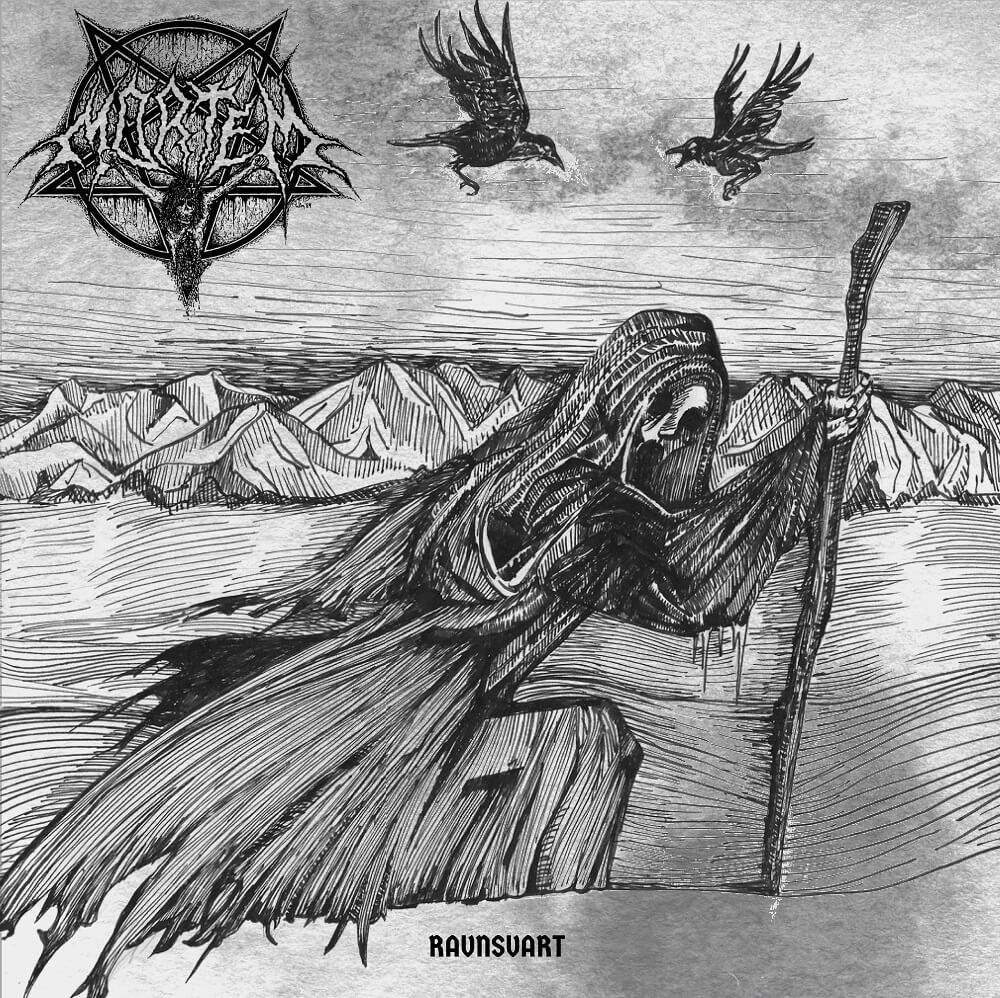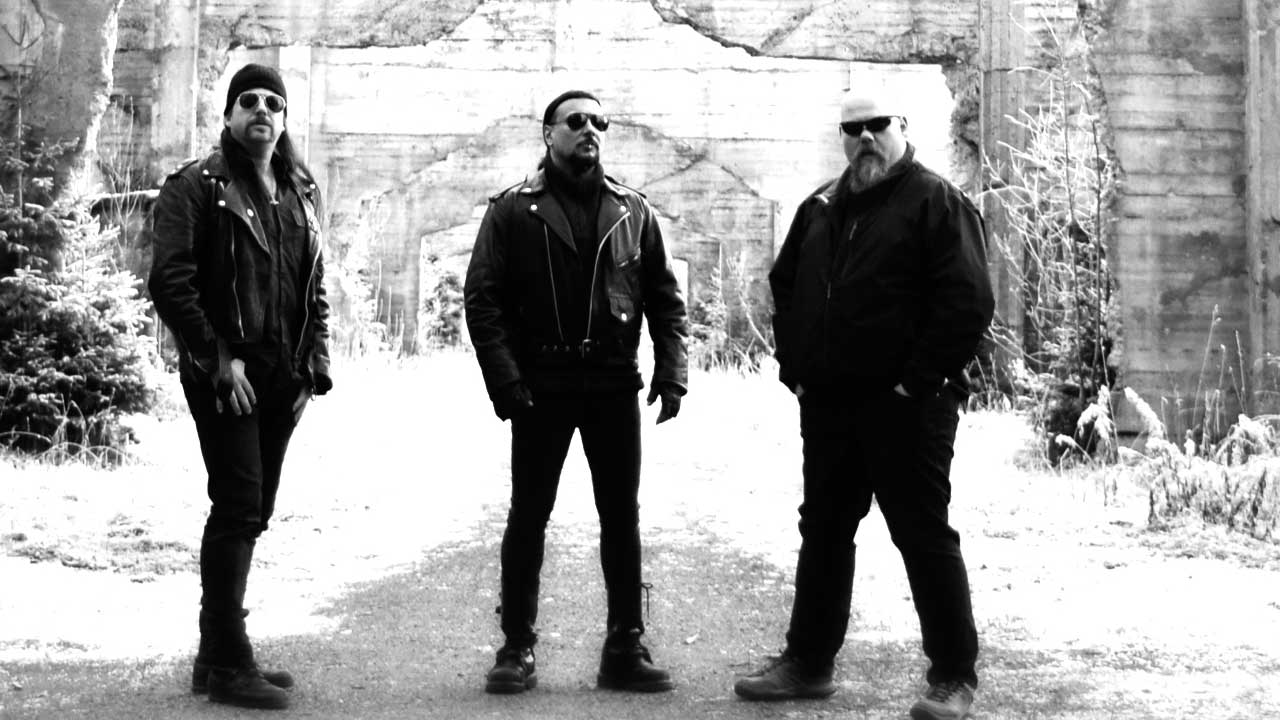
1. Ravnsvart
2. Sjelestjeler
3. Blood Horizon
4. Mørkets Monolitter
5. Truly Damned
6. Demon Shadow
7. Port Darkness
8. The Core
Original purveyors of true Norwegian black metal, Mortem, have been resurrected from the shallow grave in which they lay for three decades following their aptly named 1989 demo, Slow Death, to bring forth their first ever studio album, Ravnsvart.
Following the release of the Slow Death demo, produced by Mayhem mastermind Euronymous and featuring cover art from the legendary Mayhem/Morbid vocalist Dead, founding members Marius Vold and Steinar Sverd Johnsen continued on their black metal journeys.
Initially both musicians continued Steinar's brainchild, Arcturus, only to steer their longships in different directions with Vold focusing on his own project, Thorns.
“Reviving Mortem was something we had thought about for a long time," explains Steinar.
"Due to increasing creative differences it was a natural move to drag Mortem out of the ground, and come together with other brilliant additions to the band, to make something evil, fast, and heavy as hell, borrowing elements from Arcturus and Bathory, It’s old school while being totally unique.”
Joining the unholy duo are Hellhammer, the legendary Mayhem drummer and Steinar's long time collaborator, as well as 1349's Tor Stavenes.
Listen exclusively to Ravnsvart in full below:
1. Ravnsvart
Marius Vold: "Ravnsvart is about the power of nature, the cruelty and force of it. Nature is hard, cold and completely blind. Systematic but also random. It gives life, it takes life. 'Kulden kommer med hammerens kraft'... The cold comes with the force of a hammer, which is exactly how it feels here in Norway. If you’re not prepared, you’re doomed."
2. Sjelestjeler
Marius Vold: "This is from a story that happened 1300, 1400s period, after the Black Death decimated Norway. They extremely hard times, and the population was reduced to miserably small numbers.
"In some villages there was only one survivor. It is about a person that travelled from farm to farm, Working just long enough to get to know the farmers, and then killed them and disappeared with anything of value.
"He was a bitter, misanthropic person, completely devoid of empathy or remorse. It was normal in those times for the wife to travel together with the cattle into the mountains together with the cattle, and would look out over the entire farm daily. her husband would wave a flag or white shirt to inform her that everything was ok down there.
"One day she checked and there was no signal from her husband. she checked the following day, still nothing, so she headed down to see what the problem was and found her husband brutally murdered and all the valuables gone.
"Bereft and frightened she went to the police, and it became clear that this murderous thief was plowing his way through the remaining population, due to the reduced numbers it was painfully slow for news to spread in those days, even just from valley to valley.
"In the end he was eventually captured, he was living the high life of a lowlife, drinking and whoring, which was uncommon in those meagre times, after a fight which ended up killing one of the policemen, he was captured and hanged."
3. Blood Horizon
Marius Vold: "The inspiration for Blood Horizon came from a combination of a film and a story. It is about a leader, an Earl in this time in the middle ages, in France, and how he looked down upon the common people, and how he saw these people as his possessions and he had no respect or value for them.
"Fraught with bloodlust, When it was decided that they shall head out to battle, these 'dogs' and 'bastards' were dragged into battle with him, and of course anything plundered was never shared, so it was only this ruthless leader that enjoyed the 'joy of war'.
"Upon his return from battle he would treat his wife like a whore because he had no value for her either. Sated and rich beyond belief he would order the troops out again, the were exhausted, wounded and sick, but had no choice.
"This is how it was in Sweden in that time as well, they annihilated the entire economy anything plundered went direct to the king, who used it up of course, upon himself."
4. Mørkets Monolitter
Marius Vold: "Mørkets Monolitter is the most emotive song on the album, its about the approaching dark of night, especially out in the forest, as it seems that the darkness has just pounded down upon the trees, the lines between earth and sky become intangible.
"While shadows creep through the trees, wolves prepare for the hun (gammel grå strekker seg nå), the best way to escape the frightening night time world is the fall asleep, entering a forest of dreams."

5. Truly Damned
Hayley Johnsen (photographer and cover artist): "The inspiration behind truly damned came from a painting I saw by brilliant artist Halsey Swain. It was a cloaked skeletal figure and a staircase spiralling into oblivion.
"Her only comment/title was 'who said hell was underneath' I began imagining a person so devoid of any redeeming qualities, like the aforementioned Sjelestjeler or Donald Trump for example, who was unworthy to join the 'sinners' in hell, and was therefor cursed to eternity in decay, alone, forgotten.
"At first he thinks he's looking up upon the stars which is comforting, but it soon becomes clear that it's the flickering flames of hell he's looking upon he suffers and he realises he's truly Damned.
6. Demon Shadow
Marius Vold: "Demon Shadow is a representation of depressive feelings, plummeting deeper and deeper into the darkness, the repeating song in your head, you're standing right on the edge, no sound left, meaning the tipping point. The final curtain.
"These dark, sinister feelings haunt a depressed person, like a demon shadow you cannot escape 'demon shadow, this is me' because you are projecting it, creating it. This was from some time ago, a very dark period, which I think almost everyone on some level can relate to."
7. Port Darkness
Tor Stavenes: "The working title for Port Darkness was indeed Event Horizon, which should sum up the inspiration pretty well.
"Event Horizon was a 90s cult horror movie with some Lovecraftian influences that of course resonates very deeply with my own bleak outlook on humanity and life in general.
"The sci fi setting and thematics made me certain that once I wrote those lyrics and added the samples Steinar (Sverd) would immediately recognise the movie since it's pretty Arcturian stuff.
"Surprisingly he had no idea what I was talking about, but luckily he liked the lyrics!"
8. The Core
Marius Vold: In the beginning this song was about Øystein, 'Euronymous', "ruler of the crypt" as it were. Then as it grew it became bigger than Euronymous. It links back to him quite a bit, Its possible that it is about his somewhat grandiose vision for black metal, which led to this song having so many biblical connotations.
"'Wearing the crown of splintered bones' can be interpreted many ways: A messiah coming but not who the greater majority expect or want, accompanied by a serpent, the tempting alluring serpent of the garden of eden to lure the stricken herd into this new age.
"I think this is the easiest to understand, however like all great creations, it's the most difficult to explain."
Ravnsvart is available on CD, LP and digitally from September 27 via Peaceville, order yours now.
